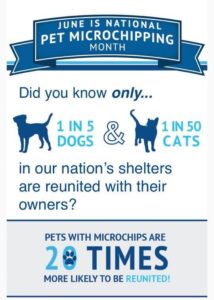
Of the millions of dogs and cats that enter US animal shelters every year, only about 20 percent of dogs and less than 2 percent of cats are ever reunited with their owners. Of those pets lucky enough to be reunited, it is usually because they were identified with a microchip and/or identification tag. Since National Microchipping Month begins in June, this is a great time to raise awareness about pet microchips, especially with more pets outside enjoying the warmer weather.
Many pet guardians worry needlessly about the procedure to implant a microchip. The microchip itself is a very small BIO-glass tag, approximately the size and shape of a grain of rice. The microchip is inserted under your pet’s skin between the shoulder blades using a special large-bore syringe. It’s a simple procedure that only takes a few minutes, and is only about as painful to your pet as getting a vaccination. Your pet doesn’t need to be sedated for the process, although it is often done while the dog or cat is in for another procedure such as spaying or neutering. The chip, which uses Radio Frequency Identification (RFID) technology, carries a unique identification number which is picked up by a special handheld scanner carried by shelters, animal control, and veterinary offices.
The microchip itself is a passive device; that is, there is no battery or power source. The glass-encased chip is inert in your pet, and there is nothing in the chip that can wear out, break or need replacement. It’s a permanent form of identification designed to last for 25 years, covering your pet for life.
In order for the system to work, it’s not enough to just have the microchip inserted; pet guardians must activate the microchip by registering the number with the appropriate registry service. Be sure to update the registry service with your new contact information whenever you move. It is also a good idea to have your veterinarian scan your pet periodically, such as during a routine exam, to make sure the microchip is still functioning properly.
When a pet becomes lost or missing, there is rarely a happy ending. A pet microchip is a simple way you can increase the chances that you will be reunited if your own beloved cat or dog goes missing. Even though my cats are strictly indoor-only cats, both of them are microchipped as a precaution in case they should escape and become lost.

Leave a Reply